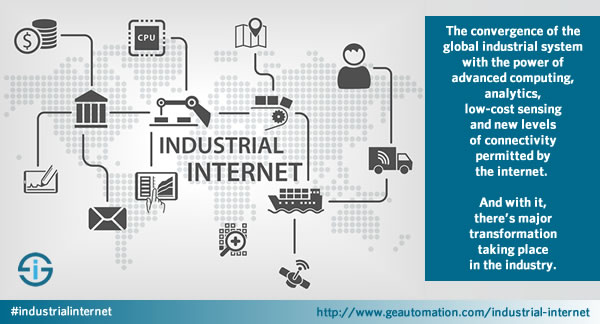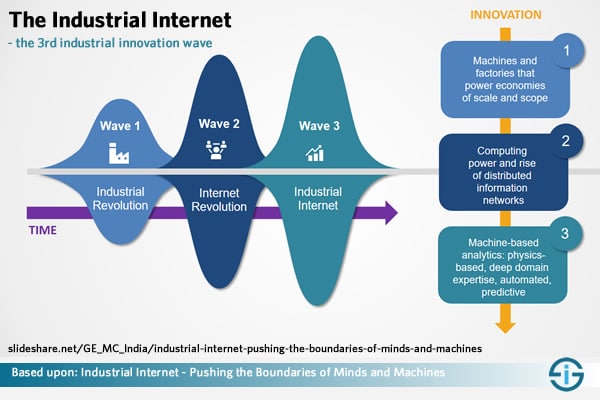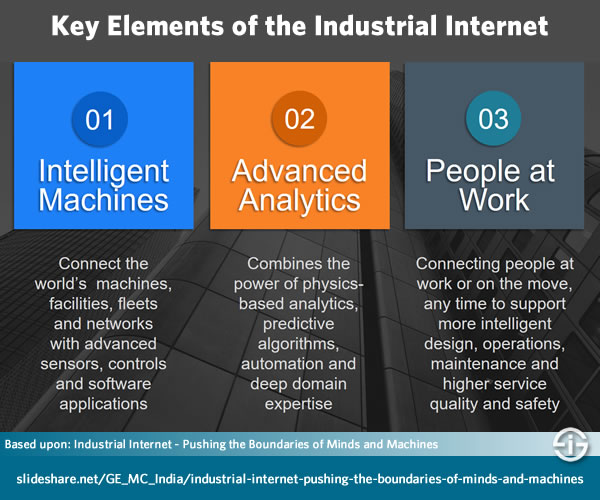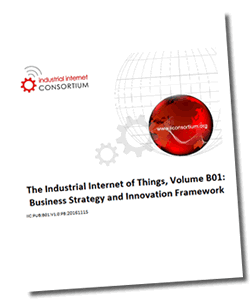We’ve explained what the Industrial Internet of Things (IIoT) is and posted an update on the state (and evolutions) regarding the IIoT market.
Maybe you also have come across another term and concept, the Industrial Internet. Is there a difference between the Industrial Internet and IoT (Internet of Things) in an industrial context? What is the Industrial Internet anyway and does it matter? Here is what you need to know.

The Industrial Internet explained: links with Industry 4.0
The term Industrial Internet was coined by GE (General Electric), one of the founding members of the Industrial Internet Consortium.
GE saw – and sees – the Industrial Internet as a third wave in industry.
Whereas Industry 4.0 is an industrial evolution concept with four stages (it is mainly used in Europe, having its roots in Germany, and mainly refers to manufacturing and the smart factory), GE identified the following 3 innovation stages in industrial environments:
- The industrial revolution, when machines and factories powered economies of scale and scope as depicted below. This first wave essentially covers the first two industrial revolutions in the Industry 4.0 view, being mechanization and the advent of water and steam power in the first one and mass production (scale) and electricity in the second one.
- The Internet revolution, which obviously also impacted industries such as oil & gas, utilities, railway transportation and healthcare to name a few of the industries we talk about here. That Internet revolution is essentially what some call the Internet age and others the digital age with the advent of computers and distributed information networks (from LANs, WANs and the client-server model to the “big one”, the Internet).
- The Industrial Internet, which is the third and current wave. It is somewhat comparable with the fourth industrial revolution in the Industry 4.0 model where we mainly talk about cyber physical systems and the integration of IT and OT. Let’s define it.
The Industrial Internet definition and the role of IIoT
GE defined the Industrial Internet as “the convergence of the global industrial system with the power of advanced computing, analytics, low-cost sensing and new levels of connectivity permitted by the internet.”

And, along with it, comes digital transformation in the industry. You can read more about that definition on GE Automation’s dedicated website section here.
As you can see in the definition, the Industrial Internet is not entirely the same as the Industrial Internet of Things. After all, the global industrial system consists of many parts (including people, processes, information systems, infrastructure, all kinds of assets and also connected devices that are strictly not part of the Internet of Things as they don’t use IP-based communications) and the Industrial Internet of Things piece is more in the dimensions of low-cost sensing and new levels of connectivity as mentioned in GE’s definition.
In a way, if you include that people and process part of the industrial system, the advanced computing and the analytics (big data and of course cognitive and AI), you could say that the Industrial Internet is a little bit like the Internet of Everything, which Cisco coined but then with a focus on ‘the industry’.
The Industrial Internet AND the Industrial Internet of Things
Still, despite the differences between the Industrial Internet and the Industrial Internet of Things, both terms are often used interchangeably.
One of the reasons is of course the huge role of the Internet of Things in the industry. Another one is the fact that the Industrial Internet Consortium (IIC), which was founded by GE and other giants such as Cisco, IBM, Intel and AT&T in 2014, set out on a mission to create standards to “connect objects, sensors and large computing systems”.
Other companies in the Industrial Internet Consortium include Bosch, Huawei, Schneider Electric, SAP (which announced a collaboration with fellow member GE Digital in November 2016 at the occasion of GE’s Mind + Machines conference), Dell, Hewlett Packard Enterprise, Pitney Bowes, Cognizant, 3M, Accenture, Gemalto (IoT security) and many dozens more as you can see on the IIC’s website. The latest member to join at the time of writing this was VMWare.

In the meantime the Industrial Internet Consortium mainly wanted to promote the Industrial Internet of Things or IIoT, another reason why the Industrial Internet and the Industrial Internet of Things are used interchangeably.
In order to push this agenda further, early November 2016, the IIC signed a ‘memorandum of understanding’ with a consortium that has the same goals: the IoT Acceleration Consortium or ITAC.
Industrial IoT initiatives and their place in the Industrial Internet
On November 2016, the IIC has published its “Business Strategy and Innovation Framework” (BSIF). You can view it here (PDF opens).
The 48-page document “serves as a reference document for chief executives in enterprises planning to engage in IIoT concepts” as the press release says. On top of Industrial Internet of Things topics it also provides recommendations on closely related matters such as IT and OT integration which is crucial in an IIoT context.
So, is there a difference between Industrial Internet and the Industrial Internet of Things?
Yes and no. We leave the last words to further illustrate both to two people from GE.
On November 15th, 2016, Jim Walsh, the President and CEO at GE Automation and Controls, said that industrial operators already sit on big mountains of data, which keep getting bigger, which makes Big Data analytics one of the top three priorities according to a report by GE and Accenture.
And the role of the Industrial Internet of Things? In order to fully leverage the possibilities, we need more than just data collection but also need to be able to use this data better for smarter operating decisions, Walsh writes. And that is the promise of the Industrial Internet of Things.
Top picture: purchased on Shutterstock. Copyright: a-image.All other pictures: see mentioned owners in image description and links.


